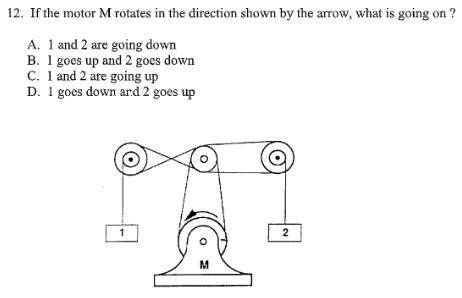
Physics, 04.11.2020 14:50 MilanPatel
If the motor M rotates in the direction shown by the arrow as illustrated in the diagram below, what is going on? A. 1 and 2 are going down B. 1 goes up and 2 goes down C. 1 and 2 are going up D. 1 goes down and 2 goes up 49) For the system in the diagram below to be in equilibrium, what is the mass of P in pounds? The mass at the other end of the beam is 5 kg.

Answers: 2
Another question on Physics

Physics, 21.06.2019 22:30
Follow these directions and answer the questions. 1. shine a pencil-thin beam of light on a mirror perpendicular to its surface. (if you don't have a laser light as suggested in the video, you can make a narrow beam from a flashlight by making a cone from black construction paper and taping it over the face of the flashlight.) how does the light reflect? how does the relationship of incident to reflected ray relate to the reflection of water waves moving perpendicular to a barrier? 2. shine a pencil-thin beam of light on a mirror standing on a sheet of paper on the table (or floor) so that you can mark the incident ray and reflected ray. (you can support the mirror from the back by taping it to a wooden block.) 3. mark a line on the paper representing the reflective surface. (the reflective surface of a mirror is usually the back edge.) 4. draw a dashed line perpendicular to the mirror surface at a point where the incident and reflected ray meet. this perpendicular is called a normal to the surface. 5. measure the angles between the rays and the normal. the angle of incidence is the angle formed by the incident ray and the normal to the surface. the angle formed by the reflected ray and normal is called the angle of reflection (r). what is the angle of incidence? what is the angle of reflection? 6. repeat for several different angles. (see report sheet for details.) what appears to be the relationship between the angle of incidence and angle of reflection? in science 1204, what was the relationship for these two angles made by the reflection of waves in a ripple tank? 7. roll a ball bearing so that it hits a fixed, hard surface (a metal plate) at several angles (including head-on). observe the way in which the ball bearing reflects. what generalization can you make about how a ball bearing reflects from a wall? have you proved that light can only behave like a wave?
Answers: 1

Physics, 22.06.2019 10:00
Students design a model roller-coaster track. they place a rubber ball at the highest point on the track and let it go. the ball rolls along the track pulled only by the force of gravity. eventually, it comes to a stop. which change to the design will result in the ball moving the greatest distance?
Answers: 1

Physics, 23.06.2019 02:00
Which statement describes the formation of our sun? a disk formed of long trails of stars coiled into a spiral. it formed an elliptical flattened disk. heat and gases contracted within a nebula. gravity pushed stars away from a center core.
Answers: 1

Physics, 23.06.2019 02:50
You are still fascinated by the process of inkjet printing, as described in the opening storyline for this chapter. you convince your father to take you to his manufacturing facility to see the machines that print expiration dates on eggs. you strike up a conversation with the technician operating the machine. he tells you that the ink drops are created using a piezoelectric crystal, acoustic waves, and the plateau-rayleigh instability, which creates uniform drops of mass m = 1.25 ✕ 10−8 g. while you don't understand the fancy words, you do recognize mass! the technician also tells you that the drops are charged to a controllable value of q and then projected vertically downward between parallel deflecting plates at a constant terminal speed of 20.0 m/s. the plates are ℓ = 2.15 cm long and have a uniform electric field of magnitude e = 6.40 ✕ 104 n/c between them. noting your interest in the process, the technician asks you, "if the position on the egg at which the drop is to be deposited requires that its deflection at the bottom end of the plates be 0.17 mm, what is the required charge on the drop (in c)? " you quickly get to work to find the answer. (neglect the force of gravity.)
Answers: 1
You know the right answer?
If the motor M rotates in the direction shown by the arrow as illustrated in the diagram below, what...
Questions




Mathematics, 19.02.2020 05:28


English, 19.02.2020 05:28






Mathematics, 19.02.2020 05:29



Computers and Technology, 19.02.2020 05:29


History, 19.02.2020 05:29

English, 19.02.2020 05:29





